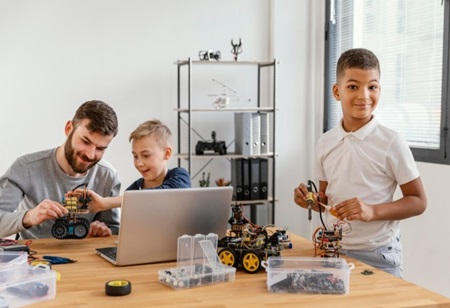-
When we talk about robotics, we think that robotics is related to math and science only. But I would like to say that with the help of robotics, we can make teaching easier for the students for any subject which is involved in education curricula like English and Social Studies. For example, in a class of literature, we can ask students to represent the journey of famous literary characters through programmed robots. In mathematics class, students can use paper robots to learn geometric shapes. They can explore and visualize the concepts of algebra when the robots run on wheels. Let’s go through the article and see how it helps students to develop their skills.
How do Students Get Benefited by Robotics Education?
Research works have shown that robotics can enhance students' learning in science, technology, engineering, mathematics and programming.
Students' three-dimensional thinking skills are enhanced by the implementation of robotics, which helps to develop technological literacy in children. Furthermore, it helps students to choose technology-related careers.
If robotics is included in the early ages then it can help student to perform experiments with their ideas and notions and develop their creative skills. Children must be made familiar with robotics in early life because it has been seen that in the early stage, students can become more familiar with the technology.
Robotics is helpful for students' STEM learning. Touching and assembling the robots give students the opportunity to learn math, physics and engineering concepts with fun.
The very important aspect is that Robotics education gives an idea of the real-world market and guides the students to become job-ready.
How Malaysia is Improving Education through Robotics?
In Malaysia, the education ministry has developed a curriculum which consists of standards-based thinking, which guides students to think about what they are learning. With the help of robotics in the curriculum, we can make ordinary learning dynamic and performance-enhancing learning.
The Malaysian economy is moving from a manufacturing-based to a service-based economy. Thus the demand for a workforce well-educated in Science and technology is going to increase in the coming times.
How Teachers can Help Incorporate Robotics into The Curriculum?
Teachers will have to play an important role in this curriculum because as we know education nowadays is more dependent on teachers rather than students. So teachers have to think and design some strategies which can engage students and encourage their interests with the help of technology.
In 21st-century classrooms, students should feel encouraged and empowered to participate in classroom activities rather than just learning from books and following traditional and old teaching models.
Students' interest in STEM should be nurtured when they are young, so a STEM approach should be integrated into the curriculum when students are in the elementary stage.
Teachers need to focus on educating the children about robotics from an early age because the problems of the real world are multidisciplinary in nature and skills from multiple disciplines are needed to solve these problems.
Renowned Academies in Asia Which have Involved Robotics in Education
In Malaysia, RoboThink has developed a STEM program which aims to make students technically strong. So that they can think innovatively and can do programming easily. These are designed for children of age groups between 5 to 15. They make students able to solve real-life problems and improve critical thinking ability.
STEM Genius helping Singaporeans to discover their passion. They aim to create more engineers and scientists for the future who will be able to transform the world through technology.
Airtics Education in Dubai is empowering students and youngsters with the right skills to develop their potential as future innovators. Through the classes of robotics and programming students develop problem-solving skills and skills to work as a team.
Top Educational Robots Currently In Use
1. mBot: It was developed by Makeblock, and is an advanced programmable robot kit. A kid with some basic knowledge of programming can use this robot to make their idea alive and transform it into reality.
2. Yahboom UNO R3 DIY: It is designed to enhance the programming knowledge of a kid. Kids can think creatively in assembling the robot parts.
3. Botley Coding Robot: This is made for older students who are learning syntax and structure of programming.
Future of Robotics in Education
Robotics education is on the rise because of many reasons. One reason is that robotics is accessible to all people of any age group. As the cost of electronic items is less, students can buy them and with the help of programming they can create simple robots. Schools are planning to involve robotics in the curriculum. The future of robotics is very good and there are plenty of opportunities for students to learn about the technologies.
Conclusion
Incorporating robotics and AI into the school curricula is a forward-thinking and modern approach to education. It helps in building critical thinking abilities, and multidisciplinary skills in students. Furthermore, students can think innovatively if robotics education is brought to students at the beginning and early ages. We are also laying the foundation for the coming generation that it should be technically sound. I hope that I have covered all the aspects of robotics and the article will help readers to understand the need and the evolution of robotics in contemporary pedagogy.
🍪 Do you like Cookies?
We use cookies to ensure you get the best experience on our website. Read more...

